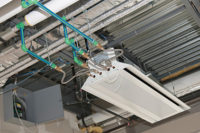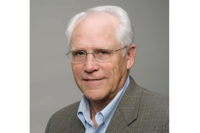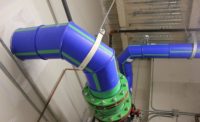Total comfort systems in commercial buildings come in three common varieties, using water, air or refrigerant. For mechanical contractors, specifying engineers and building owners, important considerations relate to a specific system’s installation, maintenance and life-cycle costs.
This guest editorial is the third in a series that compares these types of comfort systems. Previous entries focused on energy efficiency (March 2013) and cooling capabilities (July 2013).
Installation and maintenance
In general, ductwork in an air-based system is less expensive to install than water pipe, and water pipe is less expensive than refrigerant pipe. As a result, ducted air systems — especially packaged systems such as rooftop units — typically will carry a lower first cost, followed by hydronic systems and then variable-refrigerant flow systems.
At first glance, it would appear that hydronic systems carry a higher first cost because of pumps, expansion tanks and air separators that are part of the distribution system. However, because of the difficulty of controlling the flow of varying volumes of refrigerant and oil, the first costs of a VRF system are rarely lower than a hydronic system. This is due to the difficulties involved in making sure that the flow of refrigerant and oil is correct, the length of the refrigerant lines are not too long and the need to keep the compressor well-lubricated at all times.
In a VRF or direct expansion system, oil and refrigerant are mixed together and distributed throughout the system. With larger VRF systems, control of oil becomes a critical element. These systems require special attention to oil return, so installation requires more care and knowledge on the part of installers.
These systems need specialized technicians for start-up, adjustments and repairs. Refrigerant piping also requires special care in its installation in order to ensure that no contaminants enter the system and ultimately damage the compressor.
Unlike oil, the only concern in chilled-water systems is air in the system. If air enters and is not removed, the only harm that results is a decrease in the comfort level — not damage to a compressor. Joints in refrigerant systems require brazing or special soldering whereas water-based piping can be joined by a number of methods — threaded, flanged, grooved or welded for metal pipe, and glued and heated for plastic pipe.
In terms of maintenance, if a good job of installing the refrigerant pipe isn’t accomplished, such that contaminants are kept out of the system, the compressor’s operational life will be shortened.
On the other hand, hydronic or air systems don’t require special knowledge or expertise on the part of installers.
A VRF’s control system between outdoor and indoor units is strictly proprietary, which means no independent controls contractor can service, repair or upgrade the control system. Building owners are “married” to the VRF manufacturer for the life of the system. As a result of the proprietary control system, a typical building automation system using open protocol cannot communicate as well with the VRF system. The BAS therefore cannot provide the kind of in-depth operation and maintenance information available on any number of open-protocol building automation systems provided by the controls industry.
Life-cycle analysis
Life cycle is the most important piece of the puzzle. The true cost of owning a water-, air- or refrigerant-based VRF system is critical information that an owner needs to make an informed decision. An important component in choosing a system is a reasonable estimation of how long the system will last.
A VRF compressor is exposed to a significantly harder and more challenging life cycle than compressors in air or hydronic systems. A VRF compressor rejects heat to dry bulb air temperatures as opposed to wet bulb temperatures for water-cooled chillers and heat pumps and earth temperatures for geothermal heat pumps. As a result, the compressor can run at higher pressures to accomplish a similar task.
In addition, during the heating cycle, the compressor speed in VRF systems is increased to produce more heat. This increase in speed in heating is as high as double the speed in cooling. As with any rotating device, this will shorten the life of the compressor. In the hydronic industry, 1,750-rpm pumps comprise the preferred choice over 3,500-rpm pumps for this reason: longer life for the bearings, seals, wear rings, etc.
A VRF system installation requires large amounts of field-installed refrigerant tubing. The VRF industry readily acknowledges that this is a significant concern to its systems. The issues of refrigerant flow and oil migration can and will shorten the expected life of a system. Substantial opportunity exists to introduce dirt and water contamination into a field-installed refrigerant system.
In addition, the components in a VRF system are not interchangeable among manufacturers. After a decade of operation, when the VRF compressors start experiencing service issues, the owner will be forced to deal with only one supplier as well as a small and an expensive pool of specialized service mechanics.
In addition, R410A, the current refrigerant of choice for VRF systems, is an interim to some future refrigerant with less impact on the environment. When this happens, any new units will not be compatible with the existing R410A units. Building owners will not be able to replace just one unit; they will have to replace all the units and controls.
VRF repair parts and/or replacement condensers may not be readily available. VRF systems are engineered specifically to work as systems and not just a collection of various components, unlike water or air systems. This means that certain condensers must be matched with certain evaporators to function at all. VRF manufacturers, in most cases, have opted to improve the efficiency of newer products and have given little consideration to backwards compatibility. With product development cycles of seven to eight years, it is possible that an evaporator in a 10-year-old VRF system may not be replaceable.
Air and hydronic systems do not present these kinds of service issues. Most if not all refrigerant piping in these systems is factory-built, tested and certified, and contained within a small package that is shipped to the jobsite. Even an air system using an air-cooled condenser contains a small amount of field-installed refrigerant piping compared to a VRF system.
When a water-source heat pump unit might need to be changed, the owner can call almost any HVAC technician who can easily swap out the old unit with a new factory prepackaged and tested unit. This new unit could even be a different manufacturer and refrigerant. An R410A heat pump could exist next to an R22 unit.
While installation, maintenance and life-cycle costs remain critical considerations, comfort is what the HVAC industry is selling. Hydronic systems provide the best comfort — including humidity control — for occupants of commercial buildings. Hydronic systems also can be serviced by community-based independent HVAC contractors, using off-the-shelf components.
Related articles:
Hydronics systems provide better energy efficiency (March 2013)
Hydronics offers a cool, comfort advantage (July 2013).
HELPFUL LINKS:




